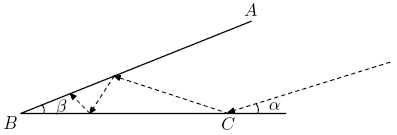Difference between revisions of "1994 AIME Problems/Problem 14"
(→Solution) |
(→Solution 2) |
||
| Line 25: | Line 25: | ||
Same as above except, the last paragraph of the above solution needs correction. | Same as above except, the last paragraph of the above solution needs correction. | ||
| − | Note that after k reflections (excluding the first one at <math>C</math>) the extended line will form an angle <math>k \beta</math> at point <math>B</math>. For the <math>k</math>th reflection to be just inside or at the point <math>C</math>, we must have <math>k\beta \le 180 - 2\alpha \Longrightarrow k \le \frac{180 - 2\alpha}{\beta} = 70.27</math>. Thus, our answer is, including the first intersection, <math>\left\lfloor \frac{180 - 2\alpha}{\beta} \right\rfloor + 1 = \boxed{071}</math>. | + | Note that after <math>k</math> reflections (excluding the first one at <math>C</math>) the extended line will form an angle <math>k \beta</math> at point <math>B</math>. For the <math>k</math>th reflection to be just inside or at the point <math>C</math>, we must have <math>k\beta \le 180 - 2\alpha \Longrightarrow k \le \frac{180 - 2\alpha}{\beta} = 70.27</math>. Thus, our answer is, including the first intersection, <math>\left\lfloor \frac{180 - 2\alpha}{\beta} \right\rfloor + 1 = \boxed{071}</math>. |
== See also == | == See also == | ||
Revision as of 12:39, 21 October 2010
Problem
A beam of light strikes ![]() at point
at point ![]() with angle of incidence
with angle of incidence ![]() and reflects with an equal angle of reflection as shown. The light beam continues its path, reflecting off line segments
and reflects with an equal angle of reflection as shown. The light beam continues its path, reflecting off line segments ![]() and
and ![]() according to the rule: angle of incidence equals angle of reflection. Given that
according to the rule: angle of incidence equals angle of reflection. Given that ![]() and
and ![]() determine the number of times the light beam will bounce off the two line segments. Include the first reflection at
determine the number of times the light beam will bounce off the two line segments. Include the first reflection at ![]() in your count.
in your count.
Solution
Solution 1
At each point of reflection, we pretend instead that the light continues to travel straight.
![[asy] pathpen = linewidth(0.7); size(250); real alpha = 28, beta = 36; pair B = D(MP("B",(0,0))), C = MP("C",D((1,0))), A = MP("A",D(expi(alpha * pi/180)),N); path r = C + .4 * expi(beta * pi/180) -- C - 2*expi(beta * pi/180); D(A--B--(1.5,0));D(r);D(anglemark(C,B,A));D(anglemark((1.5,0),C,C+.4*expi(beta*pi/180)));MP("\beta",B,(5,1.2),fontsize(9));MP("\alpha",C,(4,1.2),fontsize(9)); for(int i = 0; i < 180/alpha; ++i){ path l = B -- (1+i/2)*expi(-i * alpha * pi / 180); D(l, linetype("4 4")); D(IP(l,r)); } [/asy]](http://latex.artofproblemsolving.com/5/d/7/5d7543d66ce2d6d2c9f40193f6f340ad12927ad1.png)
Then each intersection of the extended line with the rotated segments corresponds to a reflection in the original problem. We quickly see that the extended line will intersect each rotation of the angle by ![]() until
until ![]() . Thus, our answer is, including the first intersection,
. Thus, our answer is, including the first intersection, ![]() .
.
Solution 2
Same as above except, the last paragraph of the above solution needs correction.
Note that after ![]() reflections (excluding the first one at
reflections (excluding the first one at ![]() ) the extended line will form an angle
) the extended line will form an angle ![]() at point
at point ![]() . For the
. For the ![]() th reflection to be just inside or at the point
th reflection to be just inside or at the point ![]() , we must have
, we must have ![]() . Thus, our answer is, including the first intersection,
. Thus, our answer is, including the first intersection, ![]() .
.
See also
| 1994 AIME (Problems • Answer Key • Resources) | ||
| Preceded by Problem 13 |
Followed by Problem 15 | |
| 1 • 2 • 3 • 4 • 5 • 6 • 7 • 8 • 9 • 10 • 11 • 12 • 13 • 14 • 15 | ||
| All AIME Problems and Solutions | ||










